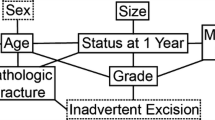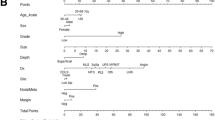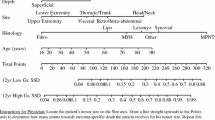Abstract
Background
It is important to understand the relative importance of prognostic variables in patients with soft tissue sarcomas. The purpose of this study was to describe the hierarchical relationships between features inherent to completely excised, localized high-grade soft tissue sarcomas of the extremity and compare the associations to those previously reported.
Methods
Data were collected from the Memorial Sloan-Kettering Cancer Center Sarcoma Database. All adult patients with high-grade extremity soft tissue sarcomas who underwent complete excision (R0 margins) at our institution between 1982 and 2010 were included in the analysis. Bayesian belief network (BBN) modeling software was used to develop a hierarchical network of features trained to estimate the likelihood of disease-specific survival. Important relationships depicted by the BBN model were compared to those previously reported.
Results
The records of 1318 consecutive patients met the inclusion criteria, and all were included in the analysis. First-degree associates of disease-specific survival were the primary tumor size; presence of and time to distant recurrence; and presence of and time to local recurrence. On cross-validation, the BBN model was sufficiently robust, with an area under the curve of 0.94 (95 % confidence interval 0.93–0.96).
Conclusions
We successfully described the hierarchical relationships between features inherent to patients with completely excised high-grade soft tissue sarcomas of the extremity. The relationships defined by the BBN model were similar to those previously reported. Cross-validation results were encouraging, demonstrating that BBN modeling can be used to graphically illustrate the complex hierarchical relationships between prognostic features in this setting.

Similar content being viewed by others
References
Collin C, Hadju SI, Godbold J, Shiu MH, Hilaris BI, Brennan MF. Localized, operable soft tissue sarcoma of the lower extremity. Arch Surg. 1986;121:1425–33.
Collin C, Hajdu SI, Godbold J, Friedrich C, Brennan MF. Localized operable soft tissue sarcoma of the upper extremity. Presentation, management, and factors affecting local recurrence in 108 patients. Ann Surg. 1987;205:331–9.
Collin CF, Friedrich C, Godbold J, Hajdu S, Brennan MF. Prognostic factors for local recurrence and survival in patients with localized extremity soft-tissue sarcoma. Semin Surg Oncol. 1988;4:30–7.
Torosian MH, Friedrich C, Godbold J, Hajdu SI, Brennan MF. Soft-tissue sarcoma: initial characteristics and prognostic factors in patients with and without metastatic disease. Semin Surg Oncol. 1988;4:13–9.
Pisters PW, Leung DH, Woodruff J, Shi W, Brennan MF. Analysis of prognostic factors in 1,041 patients with localized soft tissue sarcomas of the extremities. J Clin Oncol. 1996;14:1679–89.
Kattan MW, Leung DH, Brennan MF. Postoperative nomogram for 12-year sarcoma-specific death. J Clin Oncol. 2002;20:791–6.
Dalal KM, Kattan MW, Antonescu CR, Brennan MF, Singer S. Subtype specific prognostic nomogram for patients with primary liposarcoma of the retroperitoneum, extremity, or trunk. Ann Surg. 2006;244:381–91.
Canter RJ, Martinez SR, Tamurian RM, et al. Radiographic and histologic response to neoadjuvant radiotherapy in patients with soft tissue sarcoma. Ann Surg Oncol. 2010;17:2578–84.
Pearl J. Bayesian inference. In: Morgan M, ed. Probabilistic reasoning in intelligent systems: networks of plausible inference. San Mateo, CA: Morgan Kaufmann; 1988. pp. 29–73.
Rubin DB, Schenker N. Multiple imputation in health-care databases: an overview and some applications. Stat Med. 1991;10:585–98.
Burnside ES, Rubin DL, Fine JP, Shachter RD, Sisney GA, Leung WK. Bayesian network to predict breast cancer risk of mammographic microcalcifications and reduce number of benign biopsy results: initial experience. Radiology. 2006;240:666–73.
Stojadinovic A, Peoples GE, Libutti SK, et al. Development of a clinical decision model for thyroid nodules. BMC Surg. 2009;9:12–23.
Forsberg JA, Eberhardt J, Boland PJ, Wedin R, Healey JH. Estimating survival in patients with operable skeletal metastases: an application of a Bayesian belief network. PLoS One. 2011;6(5):e19956.
Adamina M, Tomlinson G, Guller U. Bayesian statistics in oncology: a guide for the clinical investigator. Cancer. 2009;115:5371–81.
Maskery SM, Hu H, Hooke J, Shriver C, Liebman MN. A Bayesian derived network of breast pathology co-occurrence. J Biomed Inform. 2008;41:242–50.
Peterson LT, Ford EW, Eberhardt J, Huerta TR, Menachemi N. Assessing differences between physicians’ realized and anticipated gains from electronic health record adoption. J Med Syst. 2011;35:151–61.
Pearl J. Taxonomic hierarchies, continuous variables and uncertain probabilities. In: Morgan M, ed. Probabilistic reasoning in intelligent systems: networks of plausible inference. New York, NY: Cambridge University Press; 1988. pp. 333–75.
Jensen FV. Building models. In: An introduction to Bayesian networks. New York: Springer-Verlag; 1996. pp. 33–68.
Canter RJ, Qin LX, Maki RG, Brennan MF, Ladanyi M, Singer S. A synovial sarcoma-specific preoperative nomogram supports a survival benefit to ifosfamide-based chemotherapy and improves risk stratification for patients. Clin Cancer Res. 2008;14:8191–7.
Canter RJ, Beal S, Borys D, Martinez SR, Bold RJ, Robbins AS. Interaction of histologic subtype and histologic grade in predicting survival for soft-tissue sarcomas. J Am Coll Surg. 2010;210:191–8.e2.
Stojadinovic A, Leung DH, Allen P, Lewis JJ, Jaques DP, Brennan MF. Primary adult soft tissue sarcoma: time-dependent influence of prognostic variables. J Clin Oncol. 2002;20:4344–52.
Kattan MW, Heller G, Brennan MF. A competing-risks nomogram for sarcoma-specific death following local recurrence. Stat Med. 2003;22:3515–25.
Eilber FC, Brennan MF, Riedel E, Alektiar KM, Antonescu CR, Singer S. Prognostic factors for survival in patients with locally recurrent extremity soft tissue sarcomas. Ann Surg Oncol. 2005;12:228–36.
Stajduhar I, Dalbelo-Basic B, Bogunovic N. Impact of censoring on learning Bayesian networks in survival modelling. Artif Intell Med. 2009;47:199–217.
Cox DR. Regression models and life-tables. J R Stat Soc Ser B Methodol. 1972;34:187–220.
Wunder JS, Healey JH, Davis AM, Brennan MF. A comparison of staging systems for localized extremity soft tissue sarcoma. Cancer. 2000;88:2721–30.
Acknowledgment
We thank Lionel Santibáñez for his superb editorial assistance, Mithat Gönen, PhD, for his timely statistical advice, and Nicole Moraco for helpful data assembly. Supported in part by the U.S. National Cancer Institute (Soft Tissue Sarcoma Program Project (grant P01 CA047179) and the Maynard Limb Preservation Fund.
Disclosure
There are no potential conflicts of interest.
Author information
Authors and Affiliations
Corresponding author
About this article
Cite this article
Forsberg, J.A., Healey, J.H. & Brennan, M.F. A Probabilistic Analysis of Completely Excised High-grade Soft Tissue Sarcomas of the Extremity: An Application of a Bayesian Belief Network. Ann Surg Oncol 19, 2992–3001 (2012). https://doi.org/10.1245/s10434-012-2345-z
Received:
Published:
Issue Date:
DOI: https://doi.org/10.1245/s10434-012-2345-z




